Backyards are often a sanctuary for relaxation and family gatherings, but they can also harbor hidden dangers. One such peril comes in the form of tiny eggs that could pose significant health risks. Among the most concerning are tick eggs, small yet potent threats that can introduce diseases such as Lyme disease and Rocky Mountain spotted fever into your home environment. Understanding how to identify and manage these eggs is crucial for maintaining a safe and healthy backyard.

Identifying Tick Eggs: A First Step Towards Safety
Tick eggs are incredibly small, about 0.5 mm each, similar to the size of a poppy seed. Their oval shape and subtle coloration, ranging from white to translucent, can make them difficult to spot. Typically, these eggs are found in clusters on leaves or hidden within the fallen foliage of your yard. As they mature, their color can change, often mirroring that of adult ticks.
The Danger of Tick Eggs
Ticks are not just annoying pests; they are vectors of severe diseases that can impact both humans and pets. When tick eggs hatch, they release larvae that can quickly spread throughout your yard and potentially onto family members or pets. Given their ability to transmit serious illnesses, handling tick eggs with utmost caution is imperative.

Professional Help: The Key to Effective Tick Control
Discovering tick eggs in your backyard calls for prompt and effective action. While it’s tempting to tackle the problem yourself, the safest and most effective course of action is to seek assistance from professional pest control services. Experts have the necessary tools and knowledge to manage and eliminate tick populations safely, reducing the risk of disease transmission.
Preventative Measures to Keep Ticks at Bay
To keep your backyard free from ticks, consider implementing the following preventative measures:
- Vegetation Management: Certain plants attract ticks. Removing vegetation like tulips, azaleas, or hostas can deter these pests. Instead, opt for plants like rosemary, mint, or chrysanthemums, which naturally repel ticks.
- Regular Yard Maintenance: Keep your lawn mowed and free from leaf litter and debris. This reduces the potential breeding grounds for ticks.
- Tick Tubes and Repellents: Utilizing tick tubes or applying tick repellents can further fortify your defenses against infestations.
- Garden Bed Management: Maintaining rough garden beds can help deter ticks from setting up residence in your outdoor spaces.
Safely Removing Embedded Ticks
If a tick has already attached itself to a person or pet, removing it promptly and correctly is crucial. Use fine-tipped tweezers to grasp the tick as close to the skin as possible. Apply steady, gentle pressure until the tick releases its grip. Dispose of the tick by flushing it down the toilet to ensure it cannot reattach or spread.
Collaborate with Professionals for a Tick-Free Environment
Maintaining a tick-free backyard requires ongoing vigilance and collaboration with professionals. Regularly consulting with pest control experts ensures that your yard remains a safe space for your family and pets.
Share the Knowledge
Spreading awareness about the dangers of tick eggs and effective management strategies is essential. Share this information with friends and family to help them keep their backyards safe and enjoyable.
In conclusion, the presence of tick eggs in your backyard is not just a minor inconvenience but a potential health hazard. By recognizing these risks and taking proactive steps to eliminate tick eggs and manage your yard, you can protect your family and enjoy your outdoor spaces with peace of mind.
